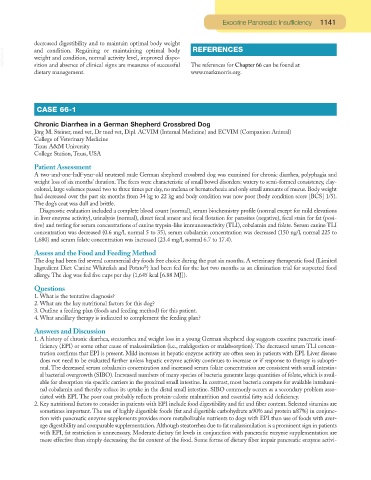Page 1096 - Small Animal Clinical Nutrition 5th Edition
P. 1096
Exocrine Pancreatic Insufficiency 1141
decreased digestibility and to maintain optimal body weight REFERENCES
VetBooks.ir and condition. Regaining or maintaining optimal body The references for Chapter 66 can be found at
weight and condition, normal activity level, improved dispo-
sition and absence of clinical signs are measures of successful
dietary management. www.markmorris.org.
CASE 66-1
Chronic Diarrhea in a German Shepherd Crossbred Dog
Jörg M. Steiner, med vet, Dr med vet, Dipl. ACVIM (Internal Medicine) and ECVIM (Companion Animal)
College of Veterinary Medicine
Texas A&M University
College Station, Texas, USA
Patient Assessment
A two-and-one-half-year-old neutered male German shepherd crossbred dog was examined for chronic diarrhea, polyphagia and
weight loss of six months’ duration. The feces were characteristic of small bowel disorders: watery to semi-formed consistency, clay-
colored, large volumes passed two to three times per day, no melena or hematochezia and only small amounts of mucus. Body weight
had decreased over the past six months from 34 kg to 22 kg and body condition was now poor (body condition score [BCS] 1/5).
The dog’s coat was dull and brittle.
Diagnostic evaluation included a complete blood count (normal), serum biochemistry profile (normal except for mild elevations
in liver enzyme activity), urinalysis (normal), direct fecal smear and fecal flotation for parasites (negative), fecal stain for fat (posi-
tive) and testing for serum concentrations of canine trypsin-like immunoreactivity (TLI), cobalamin and folate. Serum canine TLI
concentration was decreased (0.6 mg/l, normal 5 to 35), serum cobalamin concentration was decreased (150 ng/l, normal 225 to
1,680) and serum folate concentration was increased (23.4 mg/l, normal 6.7 to 17.4).
Assess and the Food and Feeding Method
The dog had been fed several commercial dry foods free choice during the past six months. A veterinary therapeutic food (Limited
a
Ingredient Diet: Canine Whitefish and Potato ) had been fed for the last two months as an elimination trial for suspected food
allergy. The dog was fed five cups per day (1,645 kcal [6.88 MJ]).
Questions
1. What is the tentative diagnosis?
2. What are the key nutritional factors for this dog?
3. Outline a feeding plan (foods and feeding method) for this patient.
4. What ancillary therapy is indicated to complement the feeding plan?
Answers and Discussion
1. A history of chronic diarrhea, steatorrhea and weight loss in a young German shepherd dog suggests exocrine pancreatic insuf-
ficiency (EPI) or some other cause of malassimilation (i.e., maldigestion or malabsorption). The decreased serum TLI concen-
tration confirms that EPI is present. Mild increases in hepatic enzyme activity are often seen in patients with EPI. Liver disease
does not need to be evaluated further unless hepatic enzyme activity continues to increase or if response to therapy is subopti-
mal. The decreased serum cobalamin concentration and increased serum folate concentration are consistent with small intestin-
al bacterial overgrowth (SIBO). Increased numbers of many species of bacteria generate large quantities of folate, which is avail-
able for absorption via specific carriers in the proximal small intestine. In contrast, most bacteria compete for available intralumi-
nal cobalamin and thereby reduce its uptake in the distal small intestine. SIBO commonly occurs as a secondary problem asso-
ciated with EPI. The poor coat probably reflects protein-calorie malnutrition and essential fatty acid deficiency.
2. Key nutritional factors to consider in patients with EPI include food digestibility and fat and fiber content. Selected vitamins are
sometimes important. The use of highly digestible foods (fat and digestible carbohydrate ≥90% and protein ≥87%) in conjunc-
tion with pancreatic enzyme supplements provides more metabolizable nutrients to dogs with EPI than use of foods with aver-
age digestibility and comparable supplementation. Although steatorrhea due to fat malassimilation is a prominent sign in patients
with EPI, fat restriction is unnecessary. Moderate dietary fat levels in conjunction with pancreatic enzyme supplementation are
more effective than simply decreasing the fat content of the food. Some forms of dietary fiber impair pancreatic enzyme activi-

